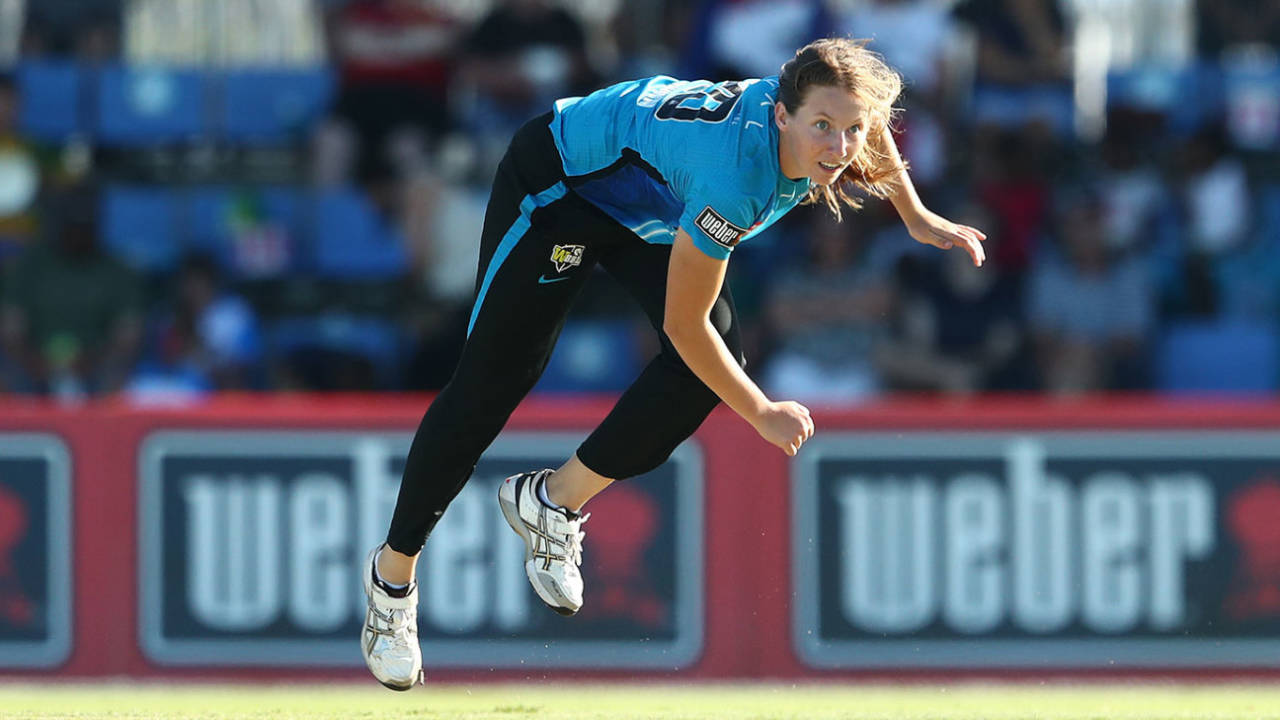The race to 130kph: NSW project aims to unlock female pace bowling
The new project is aiming to make the 130kph barrier in women's cricket a realistic mark not just to breach, but to maintain
Andrew McGlashan
20-Sep-2022
Darcie Brown has clocked around 122-125kph in WBBL and international cricket • Getty Images
It is billed as one of the new frontiers for female cricket. Who will be the first bowler to break 130kph?
There needs to be a few caveats here in that it might have already happened, but until reasonably recently, speed data in the women's game had not been widely collated and is still not uniform across competitions.
However, from currently available numbers, South Africa's Shabnim Ismail, who is regarded as one of the quickest around, is reported as being clocked at 128kph and sent down a delivery at 126.7kph against Australia at the 2020 T20 World Cup in Australia.
The former Australia quick Sharon Tredrea, who played in the 1970s and 1980s, is regarded as one of the fastest to have played the game and there are mentions of her saying she was clocked at 133kph/83mph although evidence is slim.
Now Project130, a partnership between Cricket New South Wales and the University of Technology Sydney (UTS), as part of their new Cricket Lab initiative which will see the NSW set-up work with the university on a number of collaborations, is aiming to make the 130kph barrier a realistic mark not just to breach, but then to maintain.
Described as "designed to improve the potential of female fast bowlers, with the end game of moving from bowling an average of 115kmh to 130kmh" it will be "a world first research project to develop a formative set of data which predicts potential and physiology type to increase speed and reduce injury risk."
One of the key figures behind the work is CNSW head of sports science and sports medicine Patrick Farhart. He says the evidence currently suggests the gap between male and female fast-bowling speeds is wider than other areas of high-performance sport. But he believes by studying areas including biomechanics, strength and power of those who operate at high pace, the key ingredients can be found with specialist training then put in place. There is also a desire to look outside of cricket and find athletes currently in other disciplines who may have the raw attributes for the sport.
"There are some bowlers who have gone close to that 130kph," Farhart told ESPNcricinfo. "For me this is something I think is achievable..once we are able to profile what the correlations are with high speeds then we can start to look at setting in place more individualised and targeted programmes around getting bowlers to improve their speed.

South Africa's Shabnim Ismail is among the fastest bowlers in women's cricket•Associated Press
"It's very dependent on your action, it's very specific to an individual at the moment. Males will tend to generate bowling speed through linear momentum, we think, and we think that a lot of females - not all - will generate bowling speed from upper body, trunk momentum.
"However, I think we are seeing changes in the female game now where a lot of the girls are starting to bowl with techniques which males are using and this wasn't happening anywhere near as much 10-12 years ago. Girls generating momentum through run-up speed, a braced front leg, that's starting to happen a lot more now."
Tayla Vlaeminck, who is currently injured, and Darcie Brown - the latter clocked around 122-125kph in WBBL and international cricket - are among the fastest in Australia. Elsewhere in the world, England's Issy Wong has made no secret of wanting to set a new bar for pace bowling and New Zealand's Lea Tahuhu has been among the quickest for much of her career. New South Wales and Australia quick bowler Stella Campbell is another of the current generation who has been clocked over 120kph.
"I think we aren't far off [130kph] already looking at the crop of fast bowlers we have in the game," Campbell said. "We are already pushing those speeds. It's always out there and you are trying to get that competitive edge where you can."
Rachael Haynes, who announced her international and state retirement last week, highlighted pace bowling as one of the areas that had developed most during her career.
"I think in the past there's always probably been a handful of quick bowlers and you might not necessarily have to come up against them all the time," she said. "I think it's really exciting for the game as well. Their skill is pretty evident to see too, players who can swing the ball and bowl quick bouncers - it's uncomfortable, but it's exciting to watch. I hope that's conveyed to the general public."
If this new project brings the desired results in years to come, a few more batters are likely to be hopping around.
Andrew McGlashan is a deputy editor at ESPNcricinfo
